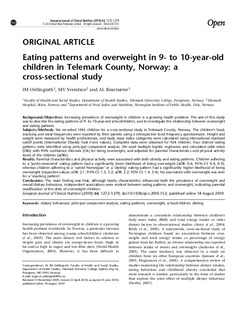| dc.description.abstract | Background/Objectives: Increasing prevalence of overweight in children is a growing health problem. The aim of this study was to describe the eating patterns of 9- to 10-year-old schoolchildren, and to investigate the relationship between overweight and eating patterns. Subjects/Methods: We recruited 1045 children for a cross-sectional study in Telemark County, Norway. The children's food, snacking and meal frequencies were reported by their parents using a retrospective food frequency questionnaire. Height and weight were measured by health professionals, and body mass index categories were calculated using international standard cutoff points (International Obesity Task Force values). Complete data were obtained for 924 children. Four distinct eating patterns were identified using principal component analysis. We used multiple logistic regression and calculated odds ratios (ORs) with 95% confidence intervals (CIs) for being overweight, and adjusted for parental characteristics and physical activity levels of the children (aORs). Results: Parental characteristics and physical activity were associated with both obesity and eating patterns. Children adhering to a ‘junk/convenient' eating pattern had a significantly lower likelihood of being overweight (aOR: 0.6; 95% CI: 0.4, 0.9), whereas children adhering to a ‘varied Norwegian' or a ‘dieting' eating pattern had a significantly higher likelihood of being overweight (respective values: aOR: 2.1; 95% CI: 1.3, 3.2; aOR: 2.2; 95% CI: 1.4, 3.4). No association with overweight was seen for a ‘snacking pattern'. Conclusions: The main finding was that, although family characteristics influenced both the prevalence of overweight and overall dietary behaviour, independent associations were evident between eating patterns and overweight, indicating parental modification of the diets of overweight children. | |
